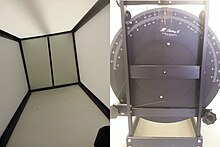
In visual perception, an optical illusion is an illusion caused by the visual system and characterized by a visual percept that arguably appears to differ from reality. Illusions come in a wide variety; their categorization is difficult because the underlying cause is often not clear but a classification proposed by Richard Gregory is useful as an orientation. According to that, there are three main classes: physical, physiological, and cognitive illusions, and in each class there are four kinds: Ambiguities, distortions, paradoxes, and fictions. A classical example for a physical distortion would be the apparent bending of a stick half immersed in water; an example for a physiological paradox is the motion aftereffect. An example for a physiological fiction is an afterimage. Three typical cognitive distortions are the Ponzo, Poggendorff, and Müller-Lyer illusion. Physical illusions are caused by the physical environment, e.g. by the optical properties of water. Physiological illusions arise in the eye or the visual pathway, e.g. from the effects of excessive stimulation of a specific receptor type. Cognitive visual illusions are the result of unconscious inferences and are perhaps those most widely known.
Psychophysics quantitatively investigates the relationship between physical stimuli and the sensations and perceptions they produce. Psychophysics has been described as "the scientific study of the relation between stimulus and sensation" or, more completely, as "the analysis of perceptual processes by studying the effect on a subject's experience or behaviour of systematically varying the properties of a stimulus along one or more physical dimensions".
Spatial disorientation is the inability to determine position or relative motion, commonly occurring during periods of challenging visibility, since vision is the dominant sense for orientation. The auditory system, vestibular system, and proprioceptive system collectively work to coordinate movement with balance, and can also create illusory nonvisual sensations, resulting in spatial disorientation in the absence of strong visual cues.

A motion simulator or motion platform is a mechanism that creates the feelings of being in a real motion environment. In a simulator, the movement is synchronised with a visual display of the outside world (OTW) scene. Motion platforms can provide movement in all of the six degrees of freedom (DOF) that can be experienced by an object that is free to move, such as an aircraft or spacecraft:. These are the three rotational degrees of freedom and three translational or linear degrees of freedom.

Human senses are not naturally geared for the in-flight environment. Pilots may experience disorientation and loss of perspective, creating illusions that range from false horizons to sensory conflict with instrument readings or the misjudging of altitude over water.
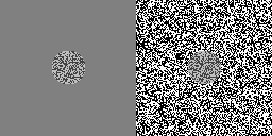
The Chubb illusion is an optical illusion or error in visual perception in which the apparent contrast of an object varies substantially to most viewers depending on its relative contrast to the field on which it is displayed. These visual illusions are of particular interest to researchers because they may provide valuable insights in regard to the workings of human visual systems.

Herman A. Witkin was an American psychologist who pioneered the development of cognitive theories, especially as they pertained to learning. While many cognitive psychologists diagnosed learning disabilities with questionnaires, he preferred projective tests and problem-solving exercises. He proposed the concept of field-dependency vs. field-independency. The majority of Witkin's research was done during his tenures at the SUNY Downstate Medical Center College of Medicine in Brooklyn, New York, and at Educational Testing Service (ETS) in Princeton, New Jersey, where he worked until his death in 1979. A Review of General Psychology survey, published in 2002, ranked Witkin as the 96th most cited psychologist of the 20th century.
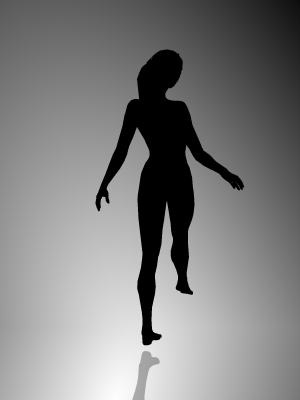
The Spinning Dancer, also known as the Silhouette Illusion, is a kinetic, bistable, animated optical illusion originally distributed as a GIF animation showing a silhouette of a pirouetting female dancer. The illusion, created in 2003 by Japanese web designer Nobuyuki Kayahara, involves the apparent direction of motion of the figure. Some observers initially see the figure as spinning clockwise and some counterclockwise. Additionally, some may see the figure suddenly spin in the opposite direction.

Illusions of self-motion occur when one perceives bodily motion despite no movement taking place. One can experience illusory movements of the whole body or of individual body parts, such as arms or legs.
In human visual perception, the visual angle, denoted θ, subtended by a viewed object sometimes looks larger or smaller than its actual value. One approach to this phenomenon posits a subjective correlate to the visual angle: the perceived visual angle or perceived angular size. An optical illusion where the physical and subjective angles differ is then called a visual angle illusion or angular size illusion.
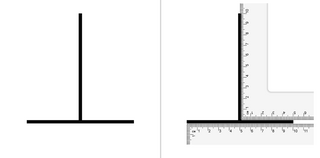
The vertical–horizontal illusion is the tendency for observers to overestimate the length of a vertical line relative to a horizontal line of the same length. This involves a bisecting component that causes the bisecting line to appear longer than the line that is bisected. People often overestimate or underestimate the length of the bisecting line relative to the bisected line of the same length. This even happens if people are aware that the lines are of the same length.

In psychology, visual capture is the dominance of vision over other sense modalities in creating a percept. In this process, the visual senses influence the other parts of the somatosensory system, to result in a perceived environment that is not congruent with the actual stimuli. Through this phenomenon, the visual system is able to disregard what other information a different sensory system is conveying, and provide a logical explanation for whatever output the environment provides. Visual capture allows one to interpret the location of sound as well as the sensation of touch without actually relying on those stimuli but rather creating an output that allows the individual to perceive a coherent environment.
The righting reflex, also known as the labyrinthine righting reflex, or the Cervico-collic reflex; is a reflex that corrects the orientation of the body when it is taken out of its normal upright position. It is initiated by the vestibular system, which detects that the body is not erect and causes the head to move back into position as the rest of the body follows. The perception of head movement involves the body sensing linear acceleration or the force of gravity through the otoliths, and angular acceleration through the semicircular canals. The reflex uses a combination of visual system inputs, vestibular inputs, and somatosensory inputs to make postural adjustments when the body becomes displaced from its normal vertical position. These inputs are used to create what is called an efference copy. This means that the brain makes comparisons in the cerebellum between expected posture and perceived posture, and corrects for the difference. The reflex takes 6 or 7 weeks to perfect, but can be affected by various types of balance disorders.

Due to the effect of a spatial context or temporal context, the perceived orientation of a test line or grating pattern can appear tilted away from its physical orientation. The tilt illusion (TI) is the phenomenon that the perceived orientation of a test line or grating is altered by the presence of surrounding lines or grating with a different orientation. And the tilt aftereffect (TAE) is the phenomenon that the perceived orientation is changed after prolonged inspection of another oriented line or grating.
Object-based attention refers to the relationship between an ‘object’ representation and a person’s visually stimulated, selective attention, as opposed to a relationship involving either a spatial or a feature representation; although these types of selective attention are not necessarily mutually exclusive. Research into object-based attention suggests that attention improves the quality of the sensory representation of a selected object, and results in the enhanced processing of that object’s features.
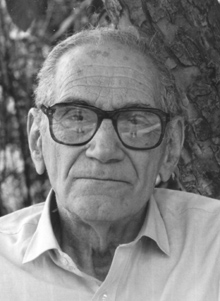
Hans Wallach was a German-American experimental psychologist whose research focused on perception and learning. Although he was trained in the Gestalt psychology tradition, much of his later work explored the adaptability of perceptual systems based on the perceiver's experience, whereas most Gestalt theorists emphasized inherent qualities of stimuli and downplayed the role of experience. Wallach's studies of achromatic surface color laid the groundwork for subsequent theories of lightness constancy, and his work on sound localization elucidated the perceptual processing that underlies stereophonic sound. He was a member of the National Academy of Sciences, a Guggenheim Fellow, and recipient of the Howard Crosby Warren Medal of the Society of Experimental Psychologists.
Biological motion perception is the act of perceiving the fluid unique motion of a biological agent. The phenomenon was first documented by Swedish perceptual psychologist, Gunnar Johansson, in 1973. There are many brain areas involved in this process, some similar to those used to perceive faces. While humans complete this process with ease, from a computational neuroscience perspective there is still much to be learned as to how this complex perceptual problem is solved. One tool which many research studies in this area use is a display stimuli called a point light walker. Point light walkers are coordinated moving dots that simulate biological motion in which each dot represents specific joints of a human performing an action.
In cognitive psychology, intertrial priming is an accumulation of the priming effect over multiple trials, where "priming" is the effect of the exposure to one stimulus on subsequently presented stimuli. Intertrial priming occurs when a target feature is repeated from one trial to the next, and typically results in speeded response times to the target. A target is the stimulus participants are required to search for. For example, intertrial priming occurs when the task is to respond to either a red or a green target, and the response time to a red target is faster if the preceding trial also has a red target.
Interindividual differences in perception describes the effect that differences in brain structure or factors such as culture, upbringing and environment have on the perception of humans. Interindividual variability is usually regarded as a source of noise for research. However, in recent years, it has become an interesting source to study sensory mechanisms and understand human behavior. With the help of modern neuroimaging methods such as fMRI and EEG, individual differences in perception could be related to the underlying brain mechanisms. This has helped to explain differences in behavior and cognition across the population. The present study using MRS provides direct evidence showing that the excitatory process in the suprasensory areas is linked to the individual differences in visual motion perception. The neurotransmitter concentration in the higher areas that execute cognitive functions is related to the interindividual variability in the perception of visual motion. Common methods include studying the perception of illusions, as they can effectively demonstrate how different aspects such as culture, genetics and the environment can influence human behavior.
Daniel M. Merfeld is an American neuroengineer, neuroscientist, academic, author, and inventor. He is a professor of Otolaryngology at The Ohio State University, and serves as Senior Vestibular Scientist at the Naval Aerospace Medical Research Laboratory, which is part of the Naval Medical Research Unit Dayton.

